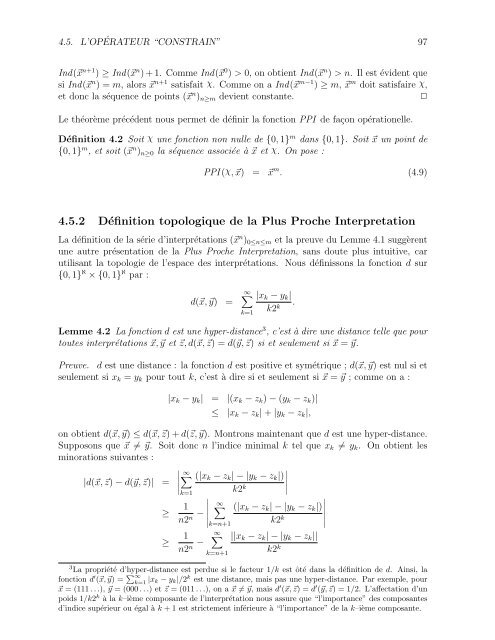Une Boite `a Outils Pour la Preuve Formelle de Syst`emes Séquentiels
Une Boite `a Outils Pour la Preuve Formelle de Syst`emes Séquentiels
Une Boite `a Outils Pour la Preuve Formelle de Syst`emes Séquentiels
You also want an ePaper? Increase the reach of your titles
YUMPU automatically turns print PDFs into web optimized ePapers that Google loves.
4.5.<br />
L’OPÉRATEUR “CONSTRAIN” 97<br />
Ind(⃗x n+1 ) ≥ Ind(⃗x n )+1. Comme Ind(⃗x 0 ) > 0, on obtient Ind(⃗x n ) > n. Il est évi<strong>de</strong>nt que<br />
si Ind(⃗x n ) = m, alors ⃗x n+1 satisfait χ. Comme on a Ind(⃗x m−1 ) ≥ m, ⃗x m doit satisfaire χ,<br />
et donc <strong>la</strong> séquence <strong>de</strong> points (⃗x n ) n≥m <strong>de</strong>vient constante.<br />
✷<br />
Le théorème précé<strong>de</strong>nt nous permet <strong>de</strong> définir <strong>la</strong> fonction PPI <strong>de</strong> façon opérationelle.<br />
Définition 4.2 Soit χ une fonction non nulle <strong>de</strong> {0,1} m dans {0,1}. Soit ⃗x un point <strong>de</strong><br />
{0,1} m , et soit (⃗x n ) n≥0 <strong>la</strong> séquence associée à ⃗x et χ. On pose :<br />
PPI(χ,⃗x) = ⃗x m . (4.9)<br />
4.5.2 Définition topologique <strong>de</strong> <strong>la</strong> Plus Proche Interpretation<br />
La définition <strong>de</strong> <strong>la</strong> série d’interprétations (⃗x n ) 0≤n≤m et <strong>la</strong> preuve du Lemme 4.1 suggèrent<br />
une autre présentation <strong>de</strong> <strong>la</strong> Plus Proche Interpretation, sans doute plus intuitive, car<br />
utilisant <strong>la</strong> topologie <strong>de</strong> l’espace <strong>de</strong>s interprétations. Nous définissons <strong>la</strong> fonction d sur<br />
{0,1} ℵ ×{0,1} ℵ par :<br />
d(⃗x,⃗y) =<br />
∞∑<br />
k=1<br />
|x k −y k |<br />
k2 k .<br />
Lemme 4.2 La fonction d est une hyper-distance 3 , c’est à dire une distance telle que pour<br />
toutes interprétations ⃗x,⃗y et ⃗z,d(⃗x,⃗z) = d(⃗y,⃗z) si et seulement si ⃗x = ⃗y.<br />
<strong>Preuve</strong>. d est une distance : <strong>la</strong> fonction d est positive et symétrique ; d(⃗x,⃗y) est nul si et<br />
seulement si x k = y k pour tout k, c’est à dire si et seulement si ⃗x = ⃗y ; comme on a :<br />
|x k −y k | = |(x k −z k )−(y k −z k )|<br />
≤ |x k −z k |+|y k −z k |,<br />
on obtient d(⃗x,⃗y) ≤ d(⃗x,⃗z)+d(⃗z,⃗y). Montrons maintenant que d est une hyper-distance.<br />
Supposons que ⃗x ≠ ⃗y. Soit donc n l’indice minimal k tel que x k ≠ y k . On obtient les<br />
minorations suivantes :<br />
∣ ∞∑ (|x k −z k |−|y k −z k |) ∣∣∣∣<br />
|d(⃗x,⃗z)−d(⃗y,⃗z)| =<br />
∣ k2 k<br />
k=1<br />
≥ 1<br />
n2 n − ∣ ∣∣∣∣∣ ∞ ∑<br />
k=n+1<br />
≥ 1<br />
n2 n − ∞ ∑<br />
k=n+1<br />
(|x k −z k |−|y k −z k |)<br />
k2 k<br />
||x k −z k |−|y k −z k ||<br />
k2 k<br />
3 La propriété d’hyper-distance est perdue si le facteur 1/k est ôté dans <strong>la</strong> définition <strong>de</strong> d. Ainsi, <strong>la</strong><br />
fonction d ′ (⃗x,⃗y) = ∑ ∞<br />
k=1 |x k −y k |/2 k est une distance, mais pas une hyper-distance. Par exemple, pour<br />
⃗x = (111...), ⃗y = (000...) et ⃗z = (011...), on a ⃗x ≠ ⃗y, mais d ′ (⃗x,⃗z) = d ′ (⃗y,⃗z) = 1/2. L’affectation d’un<br />
poids 1/k2 k à <strong>la</strong> k–ième composante <strong>de</strong> l’interprétation nous assure que “l’importance” <strong>de</strong>s composantes<br />
d’indice supérieur ou égal à k +1 est strictement inférieure à “l’importance” <strong>de</strong> <strong>la</strong> k–ième composante.<br />
∣ ∣∣∣∣∣


